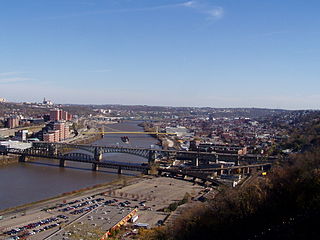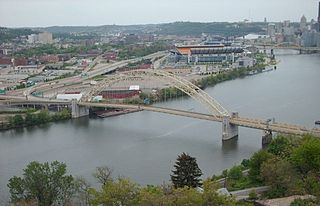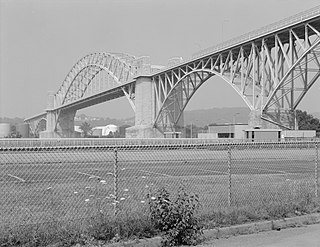
The Allegheny Portage Railroad was the first railroad constructed through the Allegheny Mountains in central Pennsylvania, United States; it operated from 1834 to 1854 as the first transportation infrastructure through the gaps of the Allegheny that connected the midwest to the eastern seaboard across the barrier range of the Allegheny Front. Approximately 36 miles (58 km) long overall, both ends connected to the Pennsylvania Canal, and the system was primarily used as a portage railway, hauling river boats and barges over the divide between the Ohio and the Susquehanna Rivers. Today, the remains of the railroad are preserved within the Allegheny Portage Railroad National Historic Site operated by the National Park Service.

The Three Sisters are three similar self-anchored suspension bridges spanning the Allegheny River in downtown Pittsburgh, Pennsylvania at 6th, 7th, and 9th streets, generally running north/south. The bridges have been given formal names to honor important Pittsburgh residents:

The Roberto Clemente Bridge, also known as the Sixth Street Bridge, spans the Allegheny River in downtown Pittsburgh, Pennsylvania, United States.

The Smithfield Street Bridge is a lenticular truss bridge crossing the Monongahela River in Pittsburgh, Pennsylvania, USA.

The Coraopolis Bridge is a girder bridge over the back channel of the Ohio River connecting Grand Avenue on Neville Island to Ferree Street in Coraopolis, Pennsylvania. It opened in 1995 to replace a structure of historic significance. The original Pratt/Bowstring/Pennsylvania through truss spans, designed by Theodore Cooper, were formerly the (third) Sixth Street Bridge, spanning the Allegheny River, in downtown Pittsburgh, and were built in 1892 by the Union Bridge Company. They were floated downstream by the Foundation Company in 1927 rather than being demolished when the bridge was removed to enable construction of the present (fourth) Three Sisters (Pittsburgh) Sixth Street Self-anchored suspension bridge. However, by the late 1980s, the old bridge could no longer support traffic volumes and was replaced by a newer structure.

The Liberty Bridge, completed in 1928, connects downtown Pittsburgh, Pennsylvania, to the Liberty Tunnels and the South Hills neighborhoods beyond. It crosses the Monongahela River and intersects Interstate 579 at its northern terminus.

The Hot Metal Bridge is a truss bridge in Pittsburgh, Pennsylvania, that crosses the Monongahela River. The bridge consists of two parallel spans on a single set of piers: the former Monongahela Connecting Railroad Bridge, built in 1887, on the upstream side and the former Hot Metal Bridge, built in 1900, on the downstream side. The Monongahela Connecting Railroad Bridge carried conventional railroad traffic, while the Hot Metal Bridge connected parts of the J&L Steel mill, carrying crucibles of molten iron from the blast furnaces in ladle transfer cars to the open hearth furnaces on the opposite bank to be converted to steel. During World War II 15% of America's steel making capacity crossed over the Hot Metal Bridge, up to 180 tons per hour. The upstream span was converted to road use after a $14.6 million restoration, and opened by Mayor Tom Murphy with a ceremony honoring former steel workers on June 23, 2000. The bridge connects 2nd Avenue at the Pittsburgh Technology Center in South Oakland with Hot Metal Street in the South Side. The downstream span reopened for pedestrian and bicycle use in late 2007 after two years of work. The Great Allegheny Passage hiker/biker trail passes over this bridge as it approaches Pittsburgh's Golden Triangle area.

The West End Bridge is a steel bowstring arch bridge over the Ohio River in Pittsburgh, Pennsylvania, approximately one mile below the confluence of the Allegheny and Monongahela Rivers. The bridge was built from 1930 to 1932 primarily by the American Bridge Company (superstructure) and the Foundation Company (substructure) and was the world's first to use tied-arch technology on a large scale. It connects the West End to the Chateau neighborhood on the North Side of Pittsburgh. The bridge was placed on the National Register of Historic Places in 1979, and the List of Pittsburgh History and Landmarks Foundation Historic Landmarks in 2001. As of 2016, the bridge and its surrounding approaches are undergoing some major reconstruction.

Rachel Carson Bridge, also known as the Ninth Street Bridge, spans the Allegheny River in Downtown Pittsburgh, Pennsylvania in the United States. The total length is 840 feet (260 m) including the 410-foot (120 m) main span and two 215-foot (66 m) side spans, or 995 feet (303 m) including the approaches. The total width of the deck is 62 feet (19 m), including the 38-foot (12 m) roadway plus two 10-foot (3.0 m) sidewalks outside the compressive plate girder. Whereas the roadway formerly carried two vehicle lanes and two streetcar tracks, it was changed to carry four wide vehicle lanes. The 2019-2020 refurbishment reduced the lanes to three.

Andy Warhol Bridge, also known as the Seventh Street Bridge, spans the Allegheny River in Downtown Pittsburgh, Pennsylvania, and is the only bridge in the United States named for a visual artist. It was opened at a cost of $1.5 million on June 17, 1926, in a ceremony attended by 2,000.

George Westinghouse Memorial Bridge in East Pittsburgh, Pennsylvania, carries U.S. Route 30, the Lincoln Highway, over the Turtle Creek Valley near to where it joins the Monongahela River Valley east of Pittsburgh. The reinforced concrete open-spandrel deck arch bridge has a total length of 1,598 feet (487 m) comprising five spans. The longest, central span is 460 feet (140 m), with the deck height 240 feet (73 m) above the valley floor, for a time the world's longest concrete arch span structure. It cost $1.75 million. The design engineers were Vernon R. Covell and George S. Richardson, with architectural design by Stanley Roush. The pylons at the ends of the bridges feature Art Deco reliefs by Frank Vittor.

The McKees Rocks Bridge is a steel trussed through arch bridge which carries the Blue Belt, Pittsburgh's innermost beltline, across the Ohio River at Brighton Heights and McKees Rocks, Pennsylvania, west of the city.

Pittsburgh, surrounded by rivers and hills, has a unique transportation infrastructure that includes roads, tunnels, bridges, railroads, inclines, bike paths, and stairways.

Schenley Tunnel is a railroad tunnel in Pittsburgh, Pennsylvania, United States. The tunnel runs beneath Neville Street in the city's North Oakland neighborhood; the south portal is at the upper end of Junction Hollow, the north in a ravine that opens into Skunk Hollow, between North Oakland and Bloomfield.

The Armstrong Tunnel in Pittsburgh, Pennsylvania, connects Second Avenue at the South Tenth Street Bridge, under the Bluff where Duquesne University is located, to Forbes Avenue between Boyd Street and Chatham Square.

The Fleming Park Bridge is a through truss bridge which spans the back channel of the Ohio River, between Neville Island and Stowe Township, PA. Although the Ohio River's back channel is only 590 feet wide, roughly 660 feet of this newer bridge was erected over water due to the unique 65 degree angle of the structure's trajectory.

The Jonathon Hulton Bridge, built in 1908, was the first major bridge designed by Allegheny County, Pennsylvania. Spanning the Allegheny River, it connected the eastern Pittsburgh suburbs of Oakmont and Harmarville, Pennsylvania. The bridge was demolished successfully with explosives at 9:49 a.m. on January 26, 2016.

The Bloomfield Bridge is a bridge in Pittsburgh, Pennsylvania, which carries four lanes of traffic across Skunk Hollow, a steep ravine between the densely populated neighborhoods of Bloomfield and Polish Hill.
Vernon R. Covell was an American engineer. He was chief engineer of the Allegheny County Public Works Department.



















